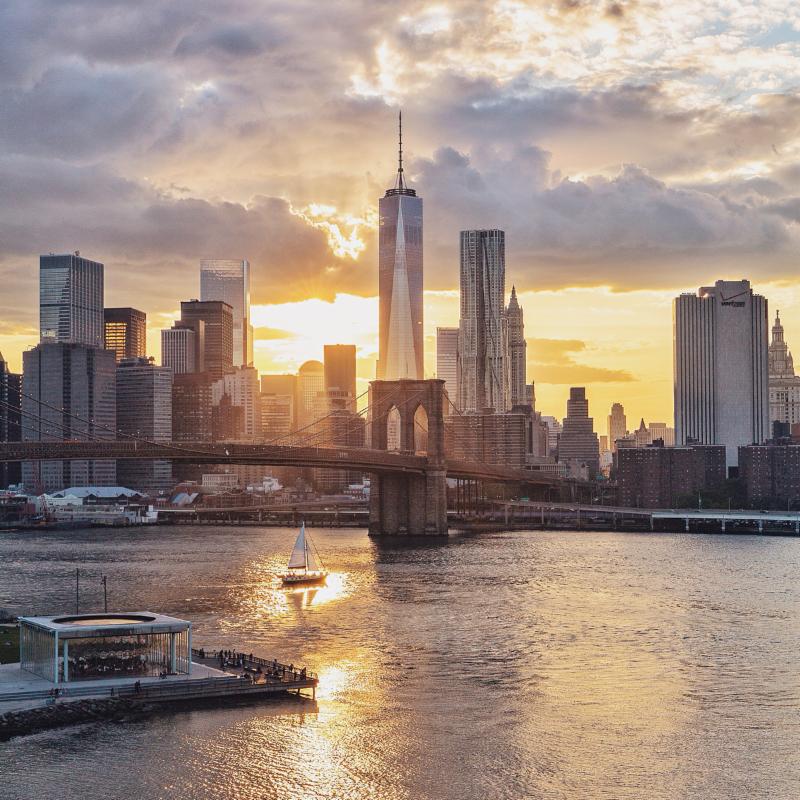A striking image of One World Trade Center captured at sunset by photographer Gerry Padden is the winner of a public photo contest hosted by Skidmore, Owings & Merrill LLP (SOM). Based in New York City, Padden typically photographs urban sites and is "always aiming to capture a special moment that is naturally occurring." His winning image was taken in July from a rooftop in Dumbo, Brooklyn.
SOM held the #WelcomeOneWTC photo contest from November 3 to December 3, 2014, to mark the official opening of One World Trade Center. As the designers of the tower, the firm encouraged both amateur and professional photographers to participate in this historic moment for New York City by submitting their personal images of the skyscraper. Approximately 350 entries were received through Instagram and email.
As the contest winner, Padden will receive a one-of-a-kind scale model of the tower, handcrafted by the firm's model shop in Manhattan, as well as a limited-edition print of One World Trade Center, taken by renowned photographer James Ewing.
The contest jury consisted of key leaders from SOM who worked on the tower: T.J. Gottesdiener, SOM Managing Partner; Kenneth A. Lewis, SOM Managing Partner; Nicole Dosso, SOM Director; and Frank Mahan, SOM Associate Director. In addition, Elizabeth Kubany, PR Consultant for SOM's New York office, and photographer James Ewing served as judges.
One World Trade Center has long captured the imagination of locals and visitors alike, who have watched the building materialize from drawings to a 104-story, crystalline skyscraper that stands boldly in Lower Manhattan. More than 13 years in the making, the 1,776-foot office tower—the tallest in the Western Hemisphere—recaptures the New York skyline, reasserts downtown Manhattan's preeminence as a global business center, and establishes a new civic icon for the country.
SOM will showcase additional entries from the #WelcomeOneWTC photo contest in the coming weeks.
Related Stories
AEC Tech Innovation | Oct 8, 2024
New ABC technology report examines how AI can enhance efficiency, innovation
The latest annual technology report from Associated Builders and Contractors delves into how artificial intelligence can enhance efficiency and innovation in the construction sector. The report includes a resource guide, a case study, insight papers, and an essay concerning applied uses for AI planning, development, and execution.
Healthcare Facilities | Oct 8, 2024
Herzog & de Meuron completes Switzerland’s largest children’s hospital
The new University Children’s Hospital Zurich features 114 rooftop patient rooms designed like wooden cottages with their own roofs. The project also includes a research and teaching facility.
Mixed-Use | Oct 7, 2024
New mixed-use tower by Studio Gang completes first phase of San Francisco waterfront redevelopment
Construction was recently completed on Verde, a new mixed-use tower along the San Francisco waterfront, marking the end of the first phase of the Mission Rock development. Verde is the fourth and final building of phase one of the 28-acre project that will be constructed in several phases guided by design principles developed by a design cohort led by Studio Gang.
Brick and Masonry | Oct 7, 2024
A journey through masonry reclad litigation
This blog post by Walter P Moore's Mallory Buckley, RRO, PE, BECxP + CxA+BE, and Bob Hancock, MBA, JD, of Munsch Hardt Kopf & Harr PC, explains the importance of documentation, correspondence between parties, and supporting the claims for a Plaintiff-party, while facilitating continuous use of the facility, on construction litigation projects.
Glass and Glazing | Oct 7, 2024
Pattern language: An exploration of digital printing on architectural glazing
Architectural Glazing has long been an important expressive tool which, when selected and detailed thoughtfully, can contribute to the successful transformation of architectural concepts to reality.
University Buildings | Oct 4, 2024
Renovations are raising higher education campuses to modern standards
AEC higher ed Giants report working on a variety of building types, from performing arts centers and libraries to business schools. Hybrid learning is seemingly here to stay. And where possible, these projects address wellness and mental health concerns.
AEC Tech | Oct 3, 2024
4 ways AI impacts building design beyond dramatic imagery
Kristen Forward, Design Technology Futures Leader, NBBJ, shows four ways the firm is using AI to generate value for its clients.
Laboratories | Oct 2, 2024
Trends in scientific research environments: Q&A with Flad's Matt McCord
As part of an ongoing series, Matt McCord, AIA, NCARB, LEED AP BD+C, Associate Principal with Flad Architects, discusses the future of the scientific workplace.
Museums | Oct 1, 2024
UT Dallas opens Morphosis-designed Crow Museum of Asian Art
In Richardson, Tex., the University of Texas at Dallas has opened a second location for the Crow Museum of Asian Art—the first of multiple buildings that will be part of a 12-acre cultural district. When completed, the arts and performance complex, called the Edith and Peter O’Donnell Jr. Athenaeum, will include two museums, a performance hall and music building, a grand plaza, and a dedicated parking structure on the Richardson campus.
Data Centers | Oct 1, 2024
10 biggest impacts to the data center market in 2024–2025
While AI sends the data center market into the stratosphere, the sector’s accelerated growth remains impacted by speed-to-market demands, supply chain issues, and design innovation necessities.

















